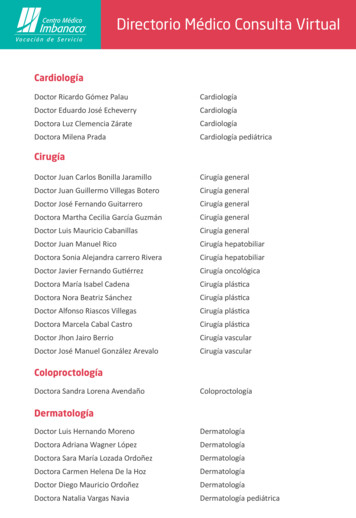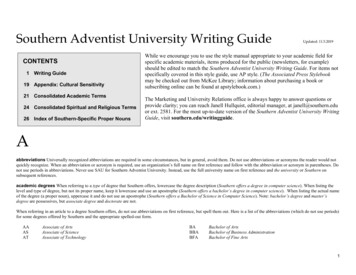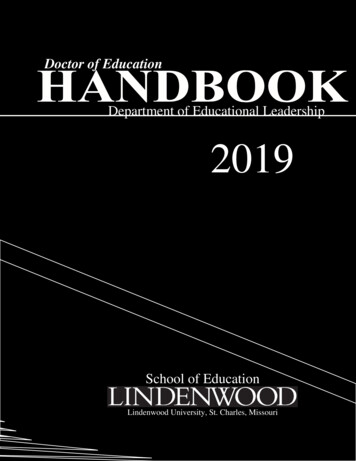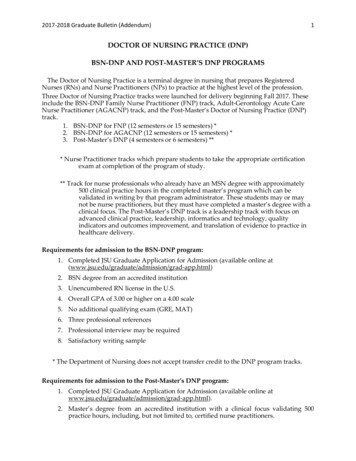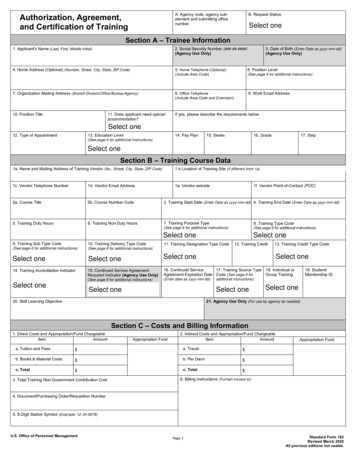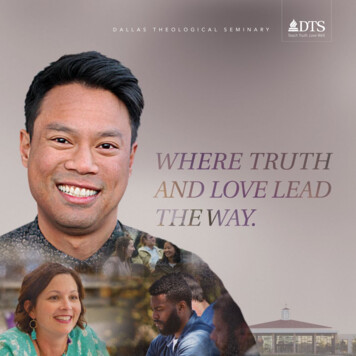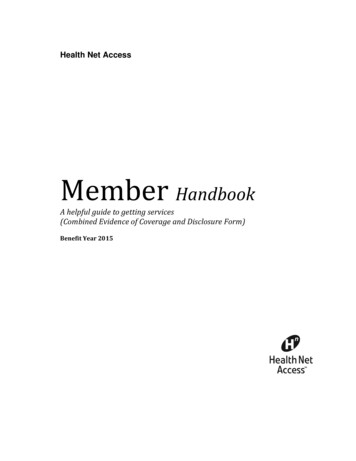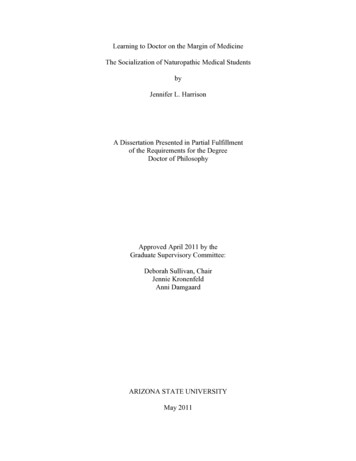
Transcription
Learning to Doctor on the Margin of MedicineThe Socialization of Naturopathic Medical StudentsbyJennifer L. HarrisonA Dissertation Presented in Partial Fulfillmentof the Requirements for the DegreeDoctor of PhilosophyApproved April 2011 by theGraduate Supervisory Committee:Deborah Sullivan, ChairJennie KronenfeldAnni DamgaardARIZONA STATE UNIVERSITYMay 2011
ABSTRACTThis research explores the socialization and culture of naturopathicstudents. Naturopathic physicians are a rapidly growing group of health careproviders with a different ideology than conventional physicians. At present theywork on the margins of the division of labor in health care. Only 15 U.S. statesexplicitly recognize, regulate, and license their practice, although the number isincreasing. Therefore, the professional socialization of naturopathic students isframed within a context of a changing division of labor in health care. The recentgrowth of naturopathic physicians reflects the American public’s increasedinterest and use of complementary and alternative medicine (CAM). However,these practitioners are not yet accepted as legitimate physicians by mostconventional physicians. This research investigates how the professionalsocialization of students at a naturopathic medical school prepares them to assumetheir role as CAM providers in a division of labor that is dominated byconventional physicians. The research examines their choice to attend anaturopathic school, formal and informal socialization at the school, and thestudent culture.The main research site is a four-year, accredited naturopathic medicalschool where participant observation, intensive interviews, and a survey wereused to collect data. Additional data are presented from observations at a nationalconference of the American Association of Naturopathic Physicians. Resultsindicate that the student culture and socialization process at the naturopathicmedical school differ in some important ways from the previously documentedi
socialization process at conventional medical schools. The average age ofnaturopathic students is much older than conventional medical students, and amuch larger percentage are women. Unlike conventional medical students, whorely heavily on role models and previous knowledge of what it takes to become amedical doctor, naturopathic students select a career path based on values andbeliefs that are more aligned with their own than conventional medicine. Theformal and informal training and culture of naturopathic students prepares them towork alongside, rather than within, mainstream medicine. The documentation ofhow a group of CAM practitioners is created contributes to a better understandingof the ever-changing ideology and division of labor in health care.ii
This project is dedicated to my grandmother, Mildred Guthery, whoalways kept me motivated to “finish that book.” I would not have perseveredthrough my graduate career without all of the lessons that I learned from her. Tothe rest of my family, thank you for going on this long journey with me. I cannotdescribe how much I appreciate your loving support and encouragement all theway through. To my parents, thank you for teaching me to look at the world witha broad perspective, which undoubtedly started me on the path to become asociologist. To my friends, old and new, thank you for all the laughter, emotionalsupport, help, and for keeping me grounded. To all of you, I couldn’t have doneany of this without you.iii
ACKNOWLEDGMENTSI would like to thank my chair, Deborah Sullivan, and my committeemembers, Jennie Kronenfeld and Anni Damgaard, who took their valuable timeand effort to devote to this project. I especially thank Deborah Sullivan for herpatience, enthusiasm, and support throughout this process. I would not havecompleted this project without her superior expertise and guidance. I would alsolike to thank my mentor, Karen Miller-Loessi, for her guidance and assistancethrough a large part of my graduate career. I also wish to thank Anni Damgaardfor all of the encouragement and support she has given me from my earlygraduate student days as a new teaching assistant, to the development of my owninstructional proficiency, and now through this dissertation process.Finally, I gratefully thank the naturopathic profession and the students,faculty, staff, and administration at the naturopathic medical school for openingtheir arms, both figuratively and literally, to me. Without their approval,openness, and honesty, I would not have had a project to begin with. Although Icannot thank specific people by name due to confidentiality, I sincerely appreciatetheir support of this project and of me.iv
TABLE OF CONTENTSPageLIST OF TABLES .viiCHAPTER1 NATUROPATHIC MEDICINE BACKGROUND . 1Types of Naturopathic Practice. 6Naturopathic Philosophy. 8Brief History of Naturopathy in America. 10Naturopathic Licensure . 20Naturopathic Scope of Practice. 22Integration With CAM Beliefs. 232 REVIEW OF MEDICAL EDUCATION LITERATURE . 26Training Versus Socialization. 26Formal Training. 27Socio-Demographics of Medical Students . 48Pay and Job Satisfaction. 50Practice Patterns of Naturopathic Physicians . 51Informal Socialization in Conventional Medical School . 53Informal Socialization in Naturopathic Medical School. 60Theoretical Framework . 61Research Questions . 693 METHODS . 70v
CHAPTERPageAmerican Association of Naturopathic Physicians ConventionSite . 71Naturopathic Medical School Site . 804 RESULTS . 96Who Attends Naturopathic Medical School? . 96What Are the Naturopathic Training and SocializationProcesses?. 132The Naturopathic Student Culture . 1645 CONCLUSIONS . 175Naturopathic Medical School Choice. 176Naturopathic Medical Training and Socialization. 179Naturopathic Student Culture. 187Study Limitations and Future Research. 188Societal Implications. 191REFERENCES . 196APPENDIXAINSTITUTIONAL REVIEW BOARD APPROVAL FORQUALITATIVE DATA COLLECTION . 206BINSTITUTIONAL REVIEW BOARD APPROVAL FOR SURVEYDATA COLLECTION . 208CINTERVIEW GUIDE . 210DSURVEY QUESTIONS . 213vi
LIST OF TABLESTablePage1.Standard Core Premedical and Recommended Courses . 322.First Two Years Curriculum Comparison of Bastyr University andUniversity of Washington . 383.A Comparison of Naturopathic and Conventional Medical Students:Age, Sex, Race, and GPA . 974.Naturopathic Student Characteristics: Religious Affiliation,Undergraduate Majors, Previous Work Experience, andEmployment . 1005.Comparing Science and Non-Science Undergraduate Tracks: CrossTabulations of Professional Experience and Health CareTraining . 1026.Naturopathic Students’ Perspectives on Social and EnvironmentalIssues . 1067.Naturopathic Students’ Career Trajectory and Professional RoleModels . 1128.Naturopathic Students’ Views on the Prevention and Management ofPatients’ Illnesses . 1149.Clinical Health Problems and Beliefs About ConventionalTreatments . 11610.Previous Experiences With Various Types of Practitioners as Factorsfor the Decision to Attend Naturopathic School. 118vii
TablePage11.Investigation of Other Types of Medical and CAM Schools. 12212.Naturopathic Students’ Training and Practice Beliefs. 12713.Naturopathic Students’ Beliefs on Respect and Collaboration WithConventional Medicine and Other CAM Practitioners. 13014.Naturopathic Students’ Values Before and After Applying toSchool . 13415.OLS Regression Models for Preparedness to Be a NaturopathicPhysician. 15116.Correlation Matrix for Cohort, Feeling Prepared, Wanting a Residency,and Belief That Students Should Obtain Residencies. 15317.OLS Regression Models for Desire to Obtain a Residency . 15418.Naturopathic Students’ Beliefs on the Current and Future Status ofNaturopathic Medicine in the United States. 15719.OLS Regression Models for Current and Future Status of NaturopathicMedicine. 15920.Naturopathic Students’ Future Plans for Naturopathic Practice. 16221.Naturopathic Students’ Beliefs on the Competitiveness orCooperativeness of Their School. 16622.Naturopathic Students’ Perceived Classmate Support. 16823.Naturopathic Students’ Perceived Beliefs and Closeness. 16924.Naturopathic Students’ Perceived Faculty Support . 171viii
Chapter 1NATUROPATHIC MEDICINE BACKGROUNDNaturopathic medicine’s underlying philosophy dates back to 400 B.C.The focus on helping the body heal itself by increasing vitality through naturalmeans originates with the Hippocratic creed of vis medicatrix naturae, whichtranslates as the healing power of nature (Kirchfeld & Boyle, 1994). However,the modern history of the naturopathic practitioners in the United States is a rollercoaster of ups and downs; naturopaths’ legal right to practice has been won, lost,and won again in some states. Naturopathy was one of many competingideologies that took root in the unregulated free market of 19th century America.The naturopathic philosophy of natural healing appealed to the sick who weredisenchanted with the aggressive, “heroic” therapies of “regular,” allopathicphysicians such as purging and bleeding and treating with addictive patentmedicines.Naturopaths began to establish formal training and state licensure at theturn of the 20th century. They eventually won licensure in 25 states (Kirchfeld &Boyle, 1994). They lost these professional privileges shortly thereafter when anallopathic organization, the American Medical Association (AMA), was put incharge of increasing the scientific rigor of medical education. By then allopathicphysicians had abandoned the most dangerous and ineffective heroic therapiesand embraced the new science of “germ theory” (Starr, 1982, p. 135). Germtheory provided a highly successful model for preventing and eventually treatinginfectious diseases, the major cause of death at the time, and for improving1
surgical outcomes with antiseptic protocols. Allopathic physicians used their newsocial status and power to campaign against competing “irregular practitioners”such as naturopaths who continued to espouse alternative philosophies about thedisease. The allopathic model of medicine, with its assumption of specificetiology, reductionism, and separation of mind and body, dominated 20th centuryhealth care. It became the conventional model of health care and was eventuallyadopted by osteopathic doctors (DOs) as well, who are now equivalent toallopathic doctors (Cody, 1999, p. 36). These conventional physicians use a morereductionistic, mechanical, interventionistic response to illness than naturopathicphysicians.Hobbled by in-fighting (Kirchfeld & Boyle, 1994, p. 203-204) and anideology of natural healing that lost much of its intuitive appeal when the“wonder drug” of penicillin and other antibiotics proved effective in curing manycommunicable diseases, the authority—and the practice, education, andlicensure—of naturopathic physicians, approached extinction (Baer, 2001b). In1968, a report by the United States Department of Health, Education, and Welfareon the “Independent Practitioners under Medicare” was presented to the U.S.House of Representatives. The report recommended that Medicare not beexpanded to cover naturopathic services because naturopathy was not grounded inmedical science and practitioners were inadequately prepared to offer appropriatediagnoses and treatments (Cohen, 1968). This report reflected the prevailingscientific community’s view of naturopathy at the time (Whorton, 2002, p. 289).However, by the end of the 20th century, the epidemiological transition from2
communicable to chronic diseases that cannot be understood with modernmicrobiology fueled a new disenchantment with conventional medicine and ademand for a more holistic, preventive approach to health care. This stimulatedpublic interest in complementary and alternative medicine (CAM), includingnaturopathic medicine. As a result, the naturopathic medical profession hasenjoyed significant growth in the recent past, with an increase in the number ofschools in North America, the number of students, and consequently the numberof practitioners. The number of states that currently regulate and licensenaturopathic physicians has increased as well, although naturopathic practitionersare still considered alternative practitioners by conventional doctors.Despite having the authority to diagnose and treat diseases in 15 U.S.states, the District of Columbia, Puerto Rico, the U.S. Virgin Islands, and fourCanadian provinces (Licensing States, n.d.), naturopathic ideology is still inconflict with the conventional medical model. Although some naturopathicstudents and physicians view naturopathic medicine as a complement, rather thanan alternative, to conventional health care, in the division of labor in health care inthe United States, naturopathic physicians practice on the outskirts of mainstreammedicine.Naturopathy’s marginalized status stems from practitioners’ inability toprove scientifically that naturopathic medicine benefits its patients. Althoughsome naturopathic physicians have focused on scientific and empirical evidencefor their practices, such as Bastyr’s focus on application of biomedical sciencesand Pizzorno’s focus on biomedicine and biochemistry in his co-edited Textbook3
of Natural Medicine (Whorton, 2002, p. 290), naturopathic therapies are stillbased on faith and trust in nature (p. 291). Because many naturopathic modalitiesdo not, or cannot, pass the rigorous, scientific, standard of empirical, controlled,double-blind studies, naturopathic practices lack evidence of demonstratedeffectiveness when measured by conventional standards (p. 292). Naturopathsmaintain that their approach goes further than what can be seen in clinical trialsbecause their healing focus is on the whole body, rather than impact of a singledrug. However, since the gold standard of evidence-based medicine is not met,their research and modalities are considered to lack credibility (p. 292-293). Forthis reason, naturopathic practices are often the focus of quackery reports and facecriticism, including being considered a pseudoscience.Since the AMA had historically targeted chiropractors for similar reasons,they are the group of CAM practitioners that has received the most attention frommedical sociologists. Most of the sociological discussions have been about wherechiropractors fit with the health care division of labor. Wardwell, who wroteduring the 1950s and 1960s, depicted chiropractors as marginalized practitionerswho were branded as quacks by mainstream medicine (Rosenthal, 1986, pp. 2832). After chiropractors won numerous occupational privileges—such asMedicare and private insurance coverage for their services, licensure in all fiftystates, and an antitrust lawsuit that resulted in an injunction against the AMA fortrying to restrain the trade of chiropractors—Rosenthal and others argue that theycan no longer be considered excluded from the division of labor in health care(Rosenthal, 1986). Some medical sociologists now argue that they should be4
considered limited professionals (Weitz, 2007, pp. 321-322.), despite the lingeringstigma of being CAM practitioners.Although medical sociologists have paid attention to theprofessionalization of CAM practitioners, and specifically the chiropracticprofession, not much is known about the socialization of its students. Oneunpublished dissertation from 1969 that utilizes an ethnographic approach to thestudy of chiropractic students finds that students internalized the idea thatchiropractic was a stigmatized profession at the time (as cited in Baer, 2001a, p.76). There are no known published studies of the socialization of students inCAM training programs. Given that CAM has received more attention sincechiropractic has won licensure in all fifty states, it is important to examine how agroup of today’s CAM practitioners are prepared to practice in a health caresystem where they are likely to encounter discrimination from mainstreamphysicians and their allied health care workers.This research project explores why students choose to attend anaturopathic medical school, given uncertainties about the occupational privilegesof, and demand for, naturopathic practitioners in the future. It also examines howthese students are socialized to become naturopathic physicians specifically, andalternative practitioners in general. While much is known about the training,socialization, and identity formation of mainstream physicians, particularlyallopathic physicians, little is known about the training, socialization, and identityformation of alternative practitioners. Understanding the social construction of a5
specific group of alternative health care practitioners is crucial to understandingthe increasingly heterogeneous emerging division of labor in health care.Types of Naturopathic PracticeThere are now three different categories of practitioners who utilizenaturopathic medicine (Hough et al., 2001; Backgrounder, 2007). The differencesin training and practice are discussed below. To avoid confusion, the terms laynaturopaths, naturopathic physicians, and conventional practitioners who utilizenaturopathic modalities will be used in this study to distinguish them. This studyfocuses on naturopathic students who are studying to become naturopathicphysicians.Naturopathic PhysiciansNaturopathic physicians practicing in North America utilize naturopathicmedicine as their primary health care modality. They see themselves as primaryhealth care providers who focus on preventive care by utilizing the body’s naturalhealing processes, while also incorporating some allopathic treatments (Hough etal., 2001, p. 10). As primary care practitioners focused on treating acute andchronic conditions, naturopathic physicians refer cases to other medical doctorsthat are beyond their scope of practice (p. 11). Naturopathic physicians aregraduates of one of seven four-year, accredited, naturopathic medical schools inNorth America and have passed licensing exams in one of the 15 U.S. states, 2U.S. territories, and 4 Canadian provinces that currently offer licensure (LicensingStates, n.d.), which will be discussed below. Students in one of the four-yearaccredited naturopathic medical schools are the focus of the present study. The6
education, training, and licensing of these modern naturopathic physicians will bediscussed in subsequent sections of this chapter.Lay NaturopathsPractitioners who adhere to a natural health care ideology, but lacklicensure will be called lay naturopaths in this dissertation. They are also knownas traditional naturopaths, naturopathic practitioners, naturopathic consultants,true naturopaths (Hough et al., 2001, p. 53), or nature-cure doctors (Schleich,2005, p. 4). They are an eclectic group that includes practitioners who weretrained in informal apprenticeships or attended unaccredited schools. The latterinclude such correspondence schools as Clayton College of Natural Health,Trinity School of Natural Health, as well as others (see Hough et al., 2001).These practitioners tend to favor a naturopathic certification as opposed tonaturopathic medical licensing and have opposed state licensing of naturopathicphysicians. Unlike licensure, certification is a voluntary form of accreditationthat lacks the force of regulatory law over the occupation’s work. Some laynaturopaths refer to graduates of accredited schools as “allopathic naturopaths,”suggesting that they are not true naturopaths (Baer, 2001b, p. 338).Conventional Practitioners Who Utilize Naturopathic ModalitiesIn recent years conventional physicians and their allied health practitionershave begun to utilize more CAM, including naturopathic modalities, in theirpractices, due to increased demand from their patients. Andrew Weil and DeepakChopra are examples of two well-known, media-savvy allopathic physicians who7
have championed the integration of some forms of CAM into mainstreammedicine.Naturopathic PhilosophyDifferent from the allopathic approach, which is considered a mechanisticphilosophy because it views living organisms as machines, composed of materialparts and biochemical processes that interact according to the laws of nature, thenaturopathic philosophy is based on vitalism. Mechanistic, or reductionistic,science used in conventional medical treatments aims to identify the signs andsymptoms of diseases caused by externally or internally caused malfunctions inthe physical substance of the body and to develop interventions to relieve thesymptoms (Bradley, 1999). In contrast, the vitalistic philosophy underpinningnaturopathic medicine assumes that “life is too well organized to be explainedsimply as a complex assemblage of chemical and physical reactions” (Bradley,1999, p. 43). Instead, vitalism holds that living organisms are more than the sumof their parts. They have a “vital spark,” also called a “vital energy,” that issometimes equated with the concept of a soul. It confers life to what wouldotherwise be non-living organic matter. Traditional vitalistic medicine, such asHippocrates’s four humors or Chinese qi, holds that disease is a result of animbalance in the vital force. Therefore, the goal of naturopathic medicine, likethe goal of all medicine based on vitalism, is to maintain or restore thehomeostatic balance of the organism, up until the point of death (Bradley, 1999).Bradley (1999) points out that naturopathic practitioners are eclectic whenit comes to choice of treatment modalities. Some practitioners believe in a strict8
nature-cure foundation and use only hydrotherapy, diet, detoxification, andlifestyle modification; others specialize in a particular modality such ashomeopathy or acupuncture; still others rely mainly on botanicals and physicalmanipulation. Finally, there are practitioners who are personally eclectic in theirmodality choices and use a mix of everything (p. 41). Although eclecticismencompasses naturopathic practice, the naturopathic philosophy has always beenidentified with the expression vis medicatrix naturae, “the healing power ofnature” (Bradley, 1999, p. 41). The naturopathic practitioners work to build abody’s vitality because “naturopaths [see] all sickness originating within thebody” (Whorton, 2002, p. 194). Therefore, healing is the process that returnsliving systems to balance, either on their own accord, or with help frompractitioners’ therapies (Dunne et al., 2005).To the Hippocratic dictum of vis medicatrix naturae, the AmericanAssociation of Naturopathic Physicians (AANP) added five more principles:“Naturopathic medical education is imbued with a unique philosophy grounded inthe six principles of naturopathic medicine, which include holistic, nontoxicapproaches, along with an emphasis on disease prevention and optimizingwellness” (Comparing ND and MD Curricula, n.d., para. 3).According to Smith & Logan (2002, pp. 174-176), the six principles ofnaturopathy are:1. Vis Medicatrix Naturae – The Healing Power of Nature2. Tolle Causam – Identify and Treat the Cause3. Primum Non Nocere – First Do No Harm9
4. Docere – Doctor as Teacher5. Treat the Whole Person6. PreventionMost of these principles are used by other practitioners besides those who adhereto a naturopathic philosophy. Both mechanistic and vitalistic healingphilosophies believe in the healing power of nature. The differences, however,are that mechanistic healing happens at the symptom-level to eradicate thepathogenic agent that is causing harm, while the vitalistic approach works torestore the body’s homeostatic balance, and once restored, to keep the balancethrough prevention (Bradley, 1999). Naturopathic practitioners’ philosophy ismostly grounded in the vitalistic approach, but the philosophy allows room for thesometimes necessary mechanistic approach to remove disease. The mainphilosophical difference between naturopathic medicine’s philosophy and othertypes of conventional medicine is that the naturopathic approach is not tied tospecific therapies; rather it works to prevent illness and to find the least invasive,curative practice to educate and heal the whole person, mind and body (Bradley,1999, p. 49).Brief History of Naturopathy in AmericaHistorically, there has been confusion about what naturopathic medicine is(Schleich, 2005). This section gives an overview of naturopathic history toprovide a contextual background for understanding the current practice ofnaturopathic medicine in North America. There are a number of detailed historiesof the philosophy, licensing, and education of naturopathic practitioners (see10
Baer, 2001b; Bradley, 1999; Cody, 1999; Kirchfeld & Boyle, 1994; Schleich,2005; Smith & Logan, 2002; Weil, 1983; Whorton, 2002).Developments in the Early 20th CenturyAlthough naturopathic philosophy dates back to Hippocrates (Kirchfeld &Boyle, 1994), the start of naturopathy in North America begins with BenedictLust, who believed that he was cured by Father Sebastian Kneipp’s watertreatments in Germany in the late 19th century before he immigrated to the UnitedStates. Lust devoted his life to developing “naturopathy,” a term that he acquiredfrom a homeopathic practitioner, Dr. Scheel, who combined “nature” and“homeopathy.” In 1901, Lust opened the first school to award the degree ofNaturopathic Doctor (ND) in New York (Whorton, 2002, p. 194). During thissame time, another follower of Kneipp, Henry Lindlahr, began his own practice inIllinois with a similar philosophy. Lindlahr, however, refused to call his practice“naturopathy.” He preferred the term “natural therapeutics” to emphasize that hispractice was about “nature – cure,” the literal translation of naturopathy, ratherthan nature – disease (Kirchfeld & Boyle, 1994, p. 191). Today’s practice ofnaturopathy emerged from these eclectic and diverse ideas.At the time Lust started his North American naturopathic medical practice,licensure of physicians, where it existed, was optional and merely indicated amedical diploma from a medical college (Starr, 1982, p. 102). Anyone in theUnited States could call themselves a doctor whether they had attended a collegeor not. Admission to one of the many proprietary schools offering medical“degrees” was relatively easy. Formal education was not regulated and most of11
the 160 medical schools in 1900 were for-profit businesses with minimal entrancerequirements that provided minimal training in the existing science of medicine.Competing theories of disease flourished. Naturopathy joined allopathy,homeopathy, osteopathy, chiropractic, and Thomsonian medicine among others,as a competing medical ideology that attracted followers (Whorton, 2002).This 19th century “counter culture” era of
The Socialization of Naturopathic Medical Students by Jennifer L. Harrison A Dissertation Presented in Partial Fulfillment of the Requirements for the Degree Doctor of Philosophy Approved April 2011 by the Graduate Supervisory Committee: Deborah Sullivan, Chair Jennie Kronenfeld Anni Damgaard ARIZONA STATE UNIVERSITY May 2011


